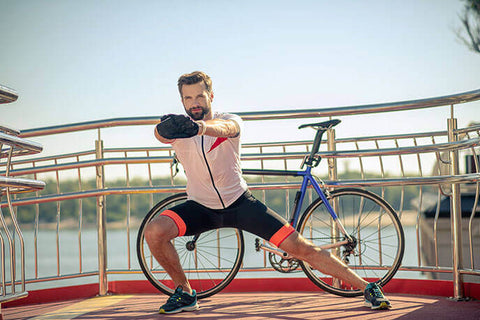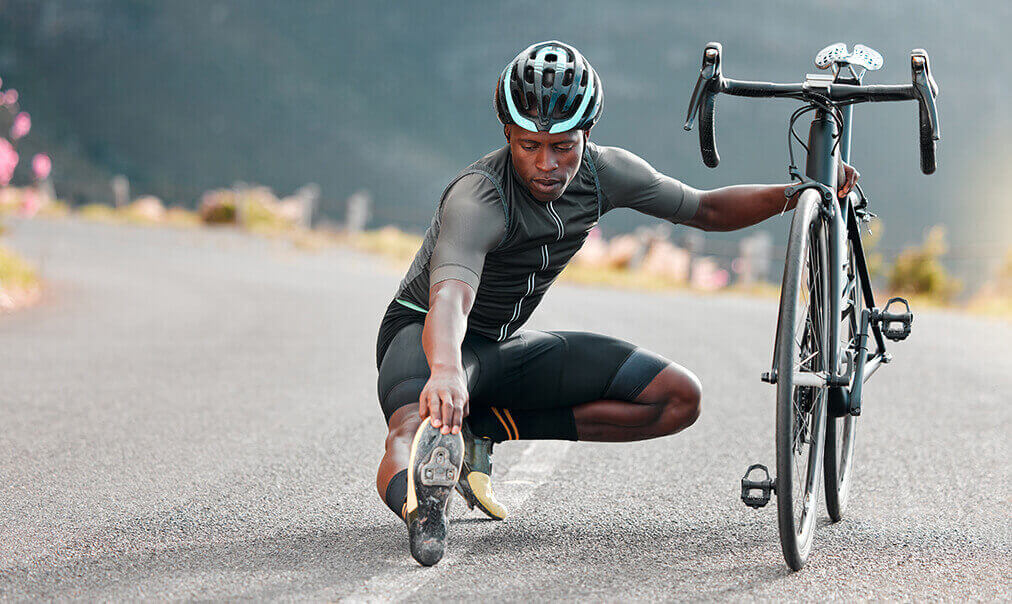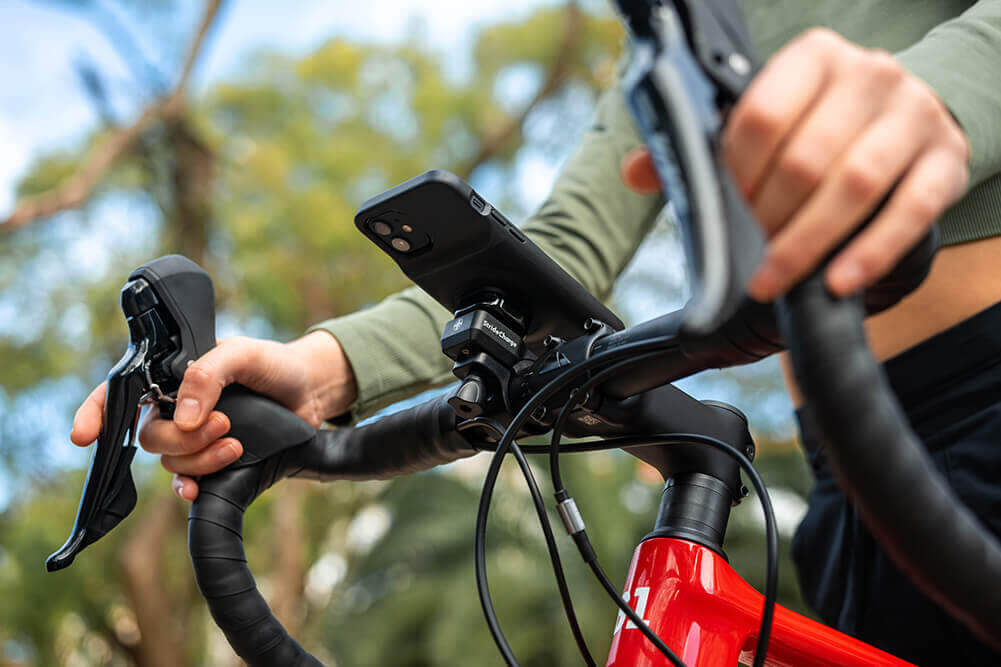Are you optimizing your cycling performance with the right stretching routine? Stretching for cyclists isn’t just a supplementary activity; it’s a critical component for maintaining flexibility, preventing injury, and enhancing rides. This guide dives straight into the stretches that directly impact your pedaling power and comfort, so you can ride longer and stronger – without the soreness.
Key Takeaways
- Regular stretching helps cyclists improve flexibility, counteract muscle imbalances, and reduce the risk of injury by enhancing joint range of motion and preventing muscle tightness.
- Cyclists should perform dynamic stretches before rides to prepare the body and static stretches post-ride for recovery, aligning the stretching type with the body’s needs during different phases of cycling activities.
- Incorporating a variety of stretching tools, such as foam rollers, straps, and yoga, into a cyclist’s routine can augment flexibility training, lead to better cycling performance, and support musculoskeletal health.
The Foundation of Flexibility for Cyclists

Cycling, though a rewarding activity, often leads to short, tightened muscles due to constant pedaling with a limited range of motion. Cyclists, bent over for prolonged periods, experience stiffness and muscle shortening, particularly in the hip flexors and hamstrings. Inflexibility can cause imbalances in musculature, leading to discomfort, pain, and even injury from tight muscles.
Here, a well-rounded stretching routine proves beneficial. Stretching helps cyclists counteract imbalances caused by the static cycling position, leading to better postures and less pain. Through stretching, cyclists can improve joint range of motion, allowing them to move more freely, reducing the risk of tissue restrictions and tears.
The Optimal Timing for Stretching in Your Cycling Routine

Understanding the optimal timing for stretching is as crucial as mastering the stretching techniques. But when is the best time to incorporate stretching into your cycling routine? Dynamic stretching, performed before cycling activities, warms up the muscles, enhancing power and performance. They kickstart your ride, preparing your body for the physical demands of cycling.
On the other hand, static stretches are best performed when muscles are warm, typically after a short general warm-up or post-ride. These stretches aid in muscle recovery, helping your body relax and recover after a strenuous ride. Incorporating both dynamic stretching in warm-ups and static stretching in cool-downs aligns with your body’s demands for flexibility, relaxation, and recovery within a cycling routine.
Dynamic Stretching: Kickstarting Your Ride
Consider dynamic stretches as your essential pre-ride preparation. They increase muscle temperature, joint range of motion, and overall flexibility, preparing your body for the ride ahead. These include movements like torso twists and lunges, all designed to adequately prepare your body for the physical demands of cycling.
We will now examine some of these dynamic stretches in detail.
Leg Swings to Loosen the Lower Body
Leg swings play a key role in enhancing hip mobility, targeting the hamstrings, quads, and calves, all essential for pedaling efficiency. They effectively warm up and stretch the following muscles in the front leg, including the left leg and left foot:
- Hip flexors
- Glutes
- Hamstrings
- Quadriceps
For a more comprehensive lower body warm-up, try variations of leg swings. Holding onto a stable object for balance, swing your leg across the body to engage the inner and outer thigh muscles. This engages more muscle groups, ensuring a well-rounded warm-up.
Torso Twists for Upper Body Mobility
Torso twists are another fantastic dynamic stretch for cyclists. By rotating the upper body from side to side and occasionally incorporating a bend forward, you help loosen the spine and improve rotational mobility, while keeping the leg straight.
Adding arm extensions during torso twists enhances the stretch in the upper back and shoulders, beneficial for maintaining a comfortable riding position. By focusing on your left arm, this stretch is a great way to kickstart your ride, preparing your upper body for the journey ahead.
High Knee Pulls to Activate Hip Flexors
High knee pulls are a great way to warm up the hip flexors. Here’s how to do them:
- Stand with your feet hip-width apart.
- Lift one knee at a time towards your chest.
- Gently pull the knee closer to your chest with your hands.
- Repeat on the other side.
By doing high knee pulls with a straight leg, you engage the hip muscles evenly on both sides.
This dynamic stretch is highly beneficial for addressing tightness and discomfort in the glutes, hips, and hamstrings, preparing them for the demands of cycling. Remember, a well-prepared body is your best ally on the road.
Static Stretching: Releasing Post-Ride Tension

Static stretching should follow your ride. These stretches improve the range of motion in muscles and joints, aiding in post-ride recovery. They help your cardiovascular system return to its resting state and support the dissipation of metabolic waste, reducing the risk of post-exercise muscle soreness.
We will now delve into some essential static stretches for your post-ride regimen.
Pigeon Pose for Deep Hip Release
The pigeon pose is a yoga exercise that offers a deep stretch targeting the hip flexors and glutes, critical areas affected by cycling. It also effectively stretches the lower back, which is beneficial after long periods of riding.
Regularly practicing the pigeon pose can alleviate sciatic pain, a common ailment among cyclists, by stretching the deep gluteal muscles. By incorporating this pose into your post-ride routine, you address tightness in the hips and enhance overall flexibility.
Hamstring Stretch for Leg Relief
The seated hamstring stretch offers relief for your back legs, promoting flexibility and ease in the cycling position. This stretch is one of the most effective ways to relieve tightness and improve flexibility in your hamstrings, which take on much of the strain during cycling.
To cool down effectively, hold this static stretch for 30 seconds and repeat for three total sets per leg, including one leg at a time. It’s a simple yet effective way to ensure your legs are ready for your next ride.
Shoulder Blade Squeeze for Upper Back Recovery
The shoulder blade squeeze is a beneficial exercise for releasing tension in the upper back and shoulder blades, common areas of stiffness after long rides. To perform this stretch, sit or stand with your back straight and pull your shoulder blades together, holding the squeeze for a few seconds.
Ensure your elbows are either at the sides with forearms parallel to the ground or extended outward, which can intensify the stretch. Relax your shoulders down away from your ears to maintain proper posture during the exercise. Aim for 10-15 repetitions to maintain upper back flexibility and strength.
Addressing Common Tight Spots in Cyclists

Cycling can lead to specific mechanical imbalances and tight spots, which, if not addressed, can lead to discomfort and reduced performance. Some common issues in cyclists include:
- Anterior pelvic tilt, which can lead to lumbar hyperextension and low back pain
- Tight hip flexors, which can cause hip pain and limited range of motion
- Weak glute muscles, which can contribute to knee pain and instability
These issues can be corrected through targeted exercises and stretches.
Lower back tightness can be alleviated through the following stretches and exercises:
- Prone press-up
- Lower trunk rotation
- Standing back bend
- Segmental cat cows
- Quadruped T-spine rotation
- Upper trunk rotations
These exercises can help improve thoracic and lumbar spine mobility.
It’s vital to have a thorough stretching routine that targets both active and inactive muscles during cycling.
Enhancing Cycling Performance Through Flexibility
Not only does increased flexibility help prevent injury and reduce soreness, it also greatly amplifies your cycling performance. It enables cyclists to maintain a powerful yet aerodynamic posture during rides and races, crucial for reducing wind resistance and enhancing performance.
Consistent stretching over months is necessary for significant improvements in flexibility, which in turn can enhance cycling performance by increasing range of motion and reducing effort. A dedicated mobility routine culminates in improved cycling performance by ensuring better posture, a full range of motion, and the ability to maintain an aerodynamic position without discomfort.
Injury Prevention and Sports Medicine Insights
Beyond enhancing performance, stretching serves a pivotal role in keeping injuries at bay. It addresses specific mechanical imbalances and is best tailored to the individual needs of the cyclist. Using straps during stretching can enhance the strength and longevity of muscle, joint, and ligament connections, contributing to injury prevention.
Consistent flexibility training not only benefits cyclists on the bike but also contributes to joint health and eases movement in daily life, offsetting the risk of daily activity-related injuries. For aging athletes, stretching prevents the degradation of tissues, stimulates the production of tissue lubricants, and maintains proper muscle fiber organization.
Daily Stretching: Building a Habit for Better Rides
Stretching yields cumulative benefits; consistency fosters better results. Consistent post-ride stretching can enhance flexibility, leading to a greater range of motion and increased freedom of movement. Increased flexibility from regular stretching contributes to a healthier muscular and skeletal system, advantageous for cycling performance.
Aim to stretch at least 2 to 3 times per week, maintaining each stretch for a minimum of 30 seconds and progressing up to 60 seconds as flexibility improves. While stretching, ensure you reach mild discomfort but not pain, and extend past the normal range of motion. Target the following muscles for stretching as these areas are commonly tightened from cycling activities:
- Quadriceps
- Hip flexors
- Hamstrings
- Lower back
- Upper back/chest muscles
Tools to Aid Stretching: From Foam Rollers to Straps
Even though traditional stretching proves effective, a variety of tools can augment the stretching process. Static stretching, foam rolling, and yoga are all recommended tools to enhance flexibility by contributing to increased range of motion and muscle relaxation.
Foam rolling targets specific muscle groups that may be difficult to stretch through traditional methods, aiding in breaking down knots and increasing blood flow. Stretching straps help in achieving more effective stretches, particularly for hard-to-reach muscles, ensuring a deeper and more controlled stretching experience.
Incorporating yoga into a cyclist’s routine complements other stretching methods, promoting whole-body relaxation and flexibility which can help in achieving a comfortable and efficient riding position.
If you are using your phone to follow a stretching or yoga routine, be sure to use a wireless phone charging case to keep your phone fully charged so you don't need to worry about your phon\e battery dying.
Summary
Stretching is a crucial part of cycling that should not be overlooked. It plays a vital role in maintaining proper posture, preventing injury, improving joint range of motion, and enhancing performance. Incorporating a regular stretching routine into your cycling regimen can bring about numerous benefits that extend beyond your ride.
Whether you’re a daily commuter or a seasoned racer, make stretching a habit for better rides. It may seem like a small task, but its impact is profound. So, let’s stretch for better cycling, shall we?
Frequently Asked Questions
Should you stretch after biking?
Yes, it's important to stretch after biking to rebalance the body's muscles and undo any repetitive strain on the joints used during cycling. Stretching immediately after riding is crucial for maintaining flexibility and preventing injury.
What not to do after cycling?
After cycling, avoid staying dirty, skipping meals, overeating, and avoiding all other movement for the rest of the day. It's important to clean up, refuel, and engage in gentle movement to aid recovery.
How do you stretch your lower back after cycling?
After cycling, you can stretch your lower back by doing the Cat-Cow Stretch. Start on your hands and knees, inhale to arch your back, then exhale to round your spine, focusing on the movement of your lower back. This will help relieve any tightness and discomfort.
Why is flexibility important for cyclists?
Flexibility is important for cyclists because it helps maintain proper posture, prevents injury, and counters imbalances caused by constant pedaling with a limited range of motion. It can lead to better posture and less pain.
When is the best time to stretch?
The best time to stretch is before and after physical activity: use dynamic stretching before exercise to warm up the muscles, and static stretching after a warm-up or post-activity to increase flexibility and reduce muscle tension.




Leave a comment
This site is protected by hCaptcha and the hCaptcha Privacy Policy and Terms of Service apply.